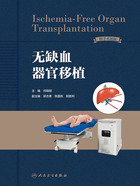
序三(原文)
Since the early start of organ transplantation, a key issue has been the preservation of organs from the time of retrieval to the point of reperfusion. The wish to preserve the function of organs was originally driven by the question to replicate cardiac function with a machine dating back into the 1880s when Max von Frey (1852—1932), while working in Carl Ludwig’s Physiological Institute in Leipzig, Germany, designed an apparatus that had criteria characteristic of a heart-lung machine. It was Alexis Carrel (1873—1944) one of the pioneers of organ transplantation and the 1912 Noble Laureate in recognition of development of vascular anastomosis and the development of tissue and organ transplantation, who in 1935 developed a type of perfusion machine together with Charles A Lindbergh (1902―1973). Using Lindbergh’s pulsating device, organs such as heart and kidney from fowls and cats were perfused with an oxygenated medium and were maintained under sterile conditions. These early attempts were further advanced by Folkert O. Belzer (1931—1995) applying machine perfusion for renal transplantation in the late 1960’ies. Since, many groups have been looking into machine perfusion for organ transplantation in order to improve the viability of organs for transplantation and particular to reduce the ischemia reperfusion damage to the organs. The clinical and scientific background was based on early observations indicating a stimulation by the immune system driven by ischemia and already reported in 1913 at the International Medicine Meeting in London by Max Borst (1869—1946) from the Department of Pathology of the University of Munich in Germany.
Since these days basically three modes of machine perfusion have been implemented, hypothermic machine perfusion (HMP), hypothermic oxygenated machine perfusion (HOPE) and normothermic machine perfusion (NMP). All three approaches have been demonstrating critical improvements but were still linked to a time of cold storage until connection to the machine. This final gap has now been closed by Prof He Xiaoshun’s group of excellent surgeons, clinicians, and scientists at Sun Yat-Sen University in Guangzhou introducing ischemia free organ transplantation (IFOT). This procedure allows for the first-time complete avoidance of ischemia and hence provides a couple of beneficial opportunities for solid organ transplantation to be examined in future trials.
Ischemia/reperfusion induced activation of the immune system is not the sole source but could work as an enhancer of the immune activation already activated by the treatment on intensive care respectively the inflammatory cascade triggered in organ donors such as shock, mechanical ventilation, cardiac arrest, and sepsis prior to brain death. Triggering such an inflammatory cascade has an impact on antigen presentation and hence on the activation of the recipient’s immune system leading to acute rejection or even laying the base for chronic rejection. The Achille heal e. g., particularly in liver transplantation is the biliary system, its sole arterial supply, and its vulnerability to ischemia/reperfusion injury.
Hence the question is raised, what is the benefit of ischemia free transplantation?
The benefit is threefold:
First it reduces the immune cascade by avoiding ischemia/reperfusion, offering the opportunity of a thorough assessment of the graft prior to transplantation applying normothermic oxygenated perfusion. That implies that the time for organ transplantation, the former so called cold ischemia time can be prolonged for reasons such as transportation.
Second a“cooling down”of the immune cascade elicited by brain death already has demonstrated in IFOT a beneficial impact on the recurrence rate of HCC after liver transplantation as well as the incidence of biliary complications.
Third does the procedure offer the opportunity of therapeutic interventions such as in marginal organs from extended criteria donors. Given the inadequate donor pool and the consistent lack of suitable organs for transplantation, we might have the chance to extend the donor pool by careful assessment of extended criteria organs under the ability of an ischemia free procedure.
The Guangzhou group under the leadership of Prof He has clearly created an outstanding platform for further experiments leading the way to improve organ transplantation and study the vulnerability of organs following brain death as well as their recovery on a genetic and proteomic level. That knowledge may identify future therapeutic targets to preserve and improve organ function. In addition, does in particular the surgical approach stress the need for specialized and excellently trained surgeons to establish high quality organ transplant centers. We have to acknowledge that organ transplantation has grown from the experimental cradle to a highly specialized profession demanding excellent longterm outcomes in order to acknowledge the gift of life from donors and their families and the promise for a normal life to the recipient. Prof He and his team definitely have been setting future standards.
Björn Nashan,M. D,Ph. D
Pre-President of the German Transplantation Society
Chief of Organ Transplant Center,The Affiliated Hospital, University of Science and Technology of China
December,2022